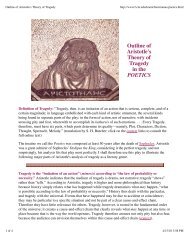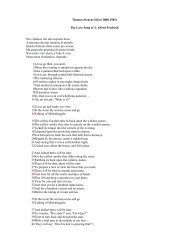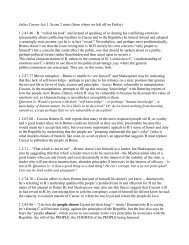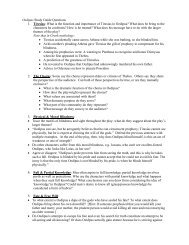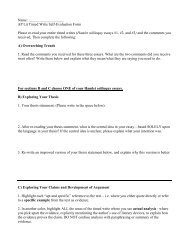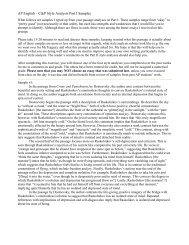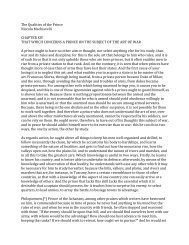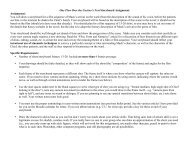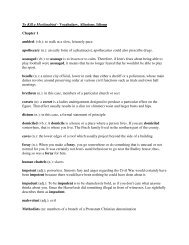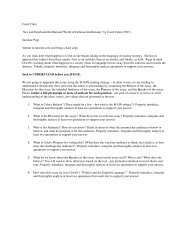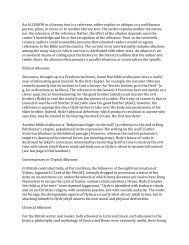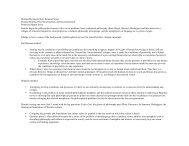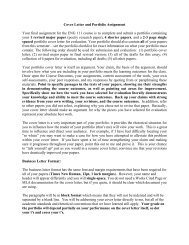50 Key Terms for AP - Adapted from: Dr. Wheeler's page of literary ...
50 Key Terms for AP - Adapted from: Dr. Wheeler's page of literary ...
50 Key Terms for AP - Adapted from: Dr. Wheeler's page of literary ...
Create successful ePaper yourself
Turn your PDF publications into a flip-book with our unique Google optimized e-Paper software.
<strong>50</strong> <strong>Key</strong> <strong>Terms</strong> <strong>for</strong> <strong>AP</strong> - <strong>Adapted</strong> <strong>from</strong>: <strong>Dr</strong>. Wheeler’s <strong>page</strong> <strong>of</strong> <strong>literary</strong> terms - http://web.cn.edu/kwheeler/index.html<br />
Underlined words indicate terms <strong>for</strong> <strong>AP</strong> English Language Exam<br />
POINT OF VIEW: The way a story gets told and who tells it. It is the method <strong>of</strong> narration that determines the position, or angle<br />
<strong>of</strong> vision, <strong>from</strong> which the story unfolds. Point <strong>of</strong> view governs the reader's access to the story. Many narratives appear in the first<br />
person (the narrator speaks as "I" and the narrator is a character in the story who may or may not influence events within it).<br />
Another common type <strong>of</strong> narrative is the third-person narrative (the narrator seems to be someone standing outside the story<br />
who refers to all the characters by name or as he, she, they, and so on). When the narrator reports speech and action, but never<br />
comments on the thoughts <strong>of</strong> other characters, it is the dramatic third person point <strong>of</strong> view or objective point <strong>of</strong> view. The<br />
third-person narrator can be omniscient--a narrator who knows everything that needs to be known about the agents and events in<br />
the story, and is free to move at will in time and place, and who has privileged access to a character's thoughts, feelings, and<br />
motives. The narrator can also be limited--a narrator who is confined to what is experienced, thought, or felt by a single<br />
character, or at most a limited number <strong>of</strong> characters. Finally, there is the unreliable narrator (a narrator who describes events in<br />
the story, but seems to make obvious mistakes or misinterpretations that may be apparent to a careful reader). Unreliable<br />
narration <strong>of</strong>ten serves to characterize the narrator as someone foolish or unobservant.<br />
QUATRAIN: Also sometimes used interchangeably with "stave," a quatrain is a stanza <strong>of</strong> four lines, <strong>of</strong>ten rhyming in an ABAB<br />
pattern.<br />
RHYME (<strong>from</strong> Old French, rime meaning "series," in turn adopted <strong>from</strong> Latin rithmus and Greek rhythmos): Also spelled rime,<br />
rhyme is a matching similarity <strong>of</strong> sounds in two or more words, especially when their accented vowels and all succeeding<br />
consonants are identical.<br />
STANZA: An arrangement <strong>of</strong> lines <strong>of</strong> verse in a pattern usually repeated throughout the poem.<br />
SYNECDOCHE: A rhetorical trope involving a part <strong>of</strong> an object representing the whole, or the whole <strong>of</strong> an object representing a<br />
part. For instance, a writer might state, "Twenty eyes watched our every move." Rather than implying that twenty disembodied<br />
eyes are swiveling to follow him as he walks by, he means that ten people watched the group's every move. When a captain calls<br />
out, "All hands on deck," he wants the whole sailors, not just their hands. When a cowboy talks about owning "<strong>for</strong>ty head <strong>of</strong><br />
cattle," he isn't talking about stuffed cowskulls hanging in his trophy room, but rather <strong>for</strong>ty live cows and their bovine bodies.<br />
When La Fontaine states, "A hungry stomach has no ears," he uses synecdoche and metonymy simultaneously to refer to the way<br />
that starving people do not want to listen to arguments.<br />
SYNTAX: Word order and sentence structure, as opposed to diction, the actual choice <strong>of</strong> words.<br />
TERCET: A three-line unit or stanza <strong>of</strong> poetry.<br />
TONE: The means <strong>of</strong> creating a relationship or conveying an attitude or mood. By looking carefully at the choices an author<br />
makes (in characters, incidents, setting; in the work's stylistic choices and diction, etc.), careful readers <strong>of</strong>ten can isolate the tone<br />
<strong>of</strong> a work and sometimes infer <strong>from</strong> it the underlying attitudes that control and color the story or poem as a whole. periodic<br />
sentence<br />
VILLANELLE: A genre <strong>of</strong> poetry consisting <strong>of</strong> nineteen lines--five tercets and a concluding quatrain. The <strong>for</strong>m requires that<br />
whole lines be repeated in a specific order, and that only two rhyming sounds occur in the course <strong>of</strong> the poem.




